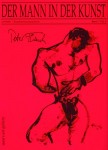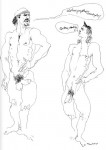Published last year, Peter Flinsch: The Body in Question (published by Arsenal Pulp Press, text by Ross Higgins1) is a fascinating monograph about an artist whose life seems to sum up gay life in the XXth century.
Born in Germany in 1920, Flinsch was in the army during the war when he was caught kissing another man. His rich and influent family probably helped him escape death in the concentration camps, but he had a hard time in various detention places, including a mine for criminals. He survived, and found employment as a theater designer before emigrating to Canada in 1953 to be with his then-lover, a professional dancer. He spent a large part of his career working for the television as a designer in Montréal, not completely closeted since he was hardly the only non-straight person working there, though his gay art was kept separated from his TV work. He regularly filled his sketchbooks with snapshots from the gay scene and with portraits of the very numerous models who posed for him. This book includes more than a hundred drawings and paintings from the early sixties until now, which means it’s only a fraction of the art Flinsch has produced over five decades.
This is only the second book to feature Flinsch’s art, after the 1995 Der Mann in der Kunst Band 4 (Man in Art Vol. 4), from gay German publisher Janssen Verlag. This 48-page, black and white collection (with very few text, all in German, English and French) is a nice complement to the new book, since no material is duplicated between the two. As an aside, this series, which had 6 volumes, offered a nice view of various gay artists and is worth looking for, especially the first book, about Jean Boullet.
But let’s go back to Flinsch’s work. The shortest description I can give of his style is that it’s somewhere in the vicinity of Jean Cocteau’s and David Hockney’s works. Flinsch certainly doesn’t work in a single style, even when one looks at the drawings of a certain period. He seems able to convey very clearly a musculature, a body gesture, and is a keen observer of the male body. A good number of his drawings are also concerned with scenes from the gay life, in bars, saunas, in the streets, etc. His sense of humor is present throughout the book, with the way he portrays interactions between gay men or with the short comments and titles he ascribes to his work. His drawings (and the few paintings and sculptures that are included in the book) are sensual but never simply photographic.
Here is a small gallery to show you the variety of works (the last one is from the Janssen book):
Notes:
- You can find more about this artist on his website (with lots of galleries), and the book is available at Amazon
, as is the Janssen book
.
ADD (June 19, 2010): While reworking this post for WordPress, I saw on his website that Peter Flinsch had died on March 30, 2010. He was 90 years old. ↩






 Bluesky feed
Bluesky feed